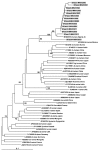Hepatitis E Virus Infections among Patients with Acute Febrile Jaundice in Burkina Faso
- PMID: 31207982
- PMCID: PMC6630816
- DOI: 10.3390/v11060554
Hepatitis E Virus Infections among Patients with Acute Febrile Jaundice in Burkina Faso
Abstract
Hepatitis E virus infection is a significant public health problem in many parts of the world including Africa. We tested serum samples from 900 patients in Burkina Faso presenting with febrile icterus. They all tested negative for yellow fever, but those from 23/900 (2.6%) patients contained markers of acute HEV infection (anti-HEV IgM and HEV RNA positive). Genotyping indicated that 14 of the strains were HEV genotype 2b. There was an overall HEV IgG seroprevalence of 18.2% (164/900). In a bivariate analysis, the factors linked to HEV exposure were climate and patient age. Older patients and those living in arid regions were more likely to have HEV infection. HEV genotype 2b circulating only in humans can be involved in some acute febrile icterus cases in Burkina Faso. Better access to safe water, sanitation, and improved personal hygiene should improve control of HEV infection in this country.
Keywords: Burkina Faso; epidemiology; hepatitis E virus; risk factors.
Conflict of interest statement
The authors declare no conflict of interest. The funders had no role in the design of the study, in the collection, analyses, or interpretation of data, in the writing of the manuscript, or in the decision to publish the results.
Figures



References
-
- Hepatitis E. WHO. [(accessed on 17 May 2019)]; Available online: http://www.who.int/mediacentre/factsheets/fs280/en/
-
- Lee G.H., Tan B.H., Teo E.C.Y., Lim S.G., Dan Y.Y., Wee A., Aw P.P.K., Zhu Y., Hibberd M.L., Tan C.K., et al. Chronic infection with camelid hepatitis e virus in a liver transplant recipient who regularly consumes camel meat and milk. Gastroenterology. 2016;150:355–357. doi: 10.1053/j.gastro.2015.10.048. - DOI - PubMed
-
- Azman A.S., Bouhenia M., Iyer A.S., Rumunu J., Laku R.L., Wamala J.F., Rodriguez-Barraquer I., Lessler J., Gignoux E., Luquero F.J., et al. High hepatitis E seroprevalence among displaced persons in South Sudan. Am. J. Trop. Med. Hyg. 2017;96:1296–1301. doi: 10.4269/ajtmh.16-0620. - DOI - PMC - PubMed
MeSH terms
Substances
LinkOut - more resources
Full Text Sources

